Mon-Fri 9am - 5pm Mountain time
Yarrow vs Baltic Rush
Achillea borealis (Previously Achillea millefolium)
Juncus balticus
SOLD OUT
CUSTOM GROW
Yarrow is a herbaceous, native wildflower that is found across Canada. It features large, flat clusters of tiny white flowers. The blooms attract a variety of pollinators, making it an ideal choice for pollinator gardens. While partial shade is tolerated, the best flowering occurs in full sun. Yarrow is resistant to deer and rabbits, making it both a beautiful and practical addition to your landscape.
The entire plant is edible, but leaves and flowers are most commonly consumed. They have a strong licorice scent and a mild sweet flavor that is similar to tarragon. Yarrow leaves can also be used as a natural insect repellent.
It is important to plant Yarrow in the right place, it can spread quickly via both rhizomes and self-seeding. Deadheading the spent flowers will extend the bloom season and can help limit self-seeding.
Baltic Rush is a widespread native perennial rush that forms dense clumps of upright, cylindrical stems. Well adapted to saturated soils, it is common in wetlands, streambanks, and riparian zones, and is tolerant of both fresh and saline conditions. Hardy and low-maintenance, Baltic Rush contributes to soil stabilization and enhances wetland habitats.
It offers cover for small animals, nesting habitat for birds, and limited forage for livestock when young and tender. Its dense growth and rhizome networks add structural diversity that supports wetland ecosystems, making it well-suited for riparian planting, shoreline stabilization, wetland restoration, and reclamation projects.
Yarrow Quick Facts
Baltic Rush Quick Facts
Toxicity: toxic to dogs, cats, and horses

